Nimrud resurgent? Views of Kalhu in the new millennium
By the year 2000, ancient Kalhu was much more visible than it had ever been before, while the site of Nimrud had never been less accessible. The second half of the twentieth century had brought dramatic changes in the ways ancient Kalhu was viewed. The Northwest Palace was re-interpreted in detail, prior to its physical and virtual reconstruction. Other buildings on the royal citadel TT were excavated and studied too. Off the mound, archaeologists explored Fort Shalmaneser and began mapping the lower town. Although the Neo-Assyrian period TT still dominated research agendas, it was becoming increasingly clear that Kalhu had been occupied for millennia. Work on site was forced to a halt by war in 1990, but this enabled a period of re-analysis and synthesis of earlier work. At the turn of the new millennium, a decade of far-reaching UN sanctions TT on Iraq seemed to be coming to an end, encouraging archaeologists to travel to and from Iraq, and new international working relationships to be forged.
The view from the Northwest Palace
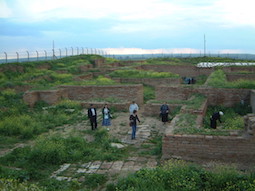
Image 1: By March 2001, when Nimrud received a large international group of visiting archaeologists, a decade of enforced neglect was taking its toll on the reconstructed Northwest Palace. This view looks west across Courtyards 80 and 72b in the southernmost area of the palace. In the background queen Yabaʾ's PGP tomb (Room 49) is protected by a makeshift metal roof. Photo by Eleanor Robson. View large image.
Layard's legacy could never be quite escaped. In the 1950s Mallowan's PGP team had revealed that the Northwest Palace was even larger and more complex than the Victorians had thought, while the few sculptural panels and fragments still lining the walls of its reception rooms emphasised the extent to which it had been plundered—for the best of intentions—a century before. So the BSAI's TT backfill TT was removed and in 1974 a Polish team, led by Janusz Meuszyński PGP , began a thorough reanalysis of the remaining bas-reliefs TT . Building on Cyril Gadd's PGP pioneering work of the interwar period, they also sought to re-locate all 196 stone sculptures that had been removed from the palace in the 19th century (1). Despite Meuszýnski's sudden death in 1976, the team impressively succeeded in reconstructing the original decorative scheme, in print if not in the palace itself (2), (3), (4) .
At the same time, the Iraqi State Board of Antiquities and Heritage TT wanted to make Nimrud an attractive and exciting place for visitors. Iraqi archaeologists, architects and conservators TT carried out a long-tem project to rebuild Northwest Palace's fragile mud-brick walls TT and protect the last of the sculptures (5). It was now possible for visitors to walk through the roofless throne room and reception suites of the palace, mentally recreating its original opulence and splendour (Image 1).
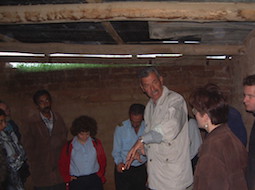
Image 2: Muzahim Mahmoud PGP , Iraqi excavator of the royal burials of Nimrud, gives archaeological visitors a tour of Queen Yabaʾ's tomb in March 2001. Photo by Eleanor Robson. View large image.
In the course of clearing rooms in the southern part of the palace, which Mallowan's team had not fully excavated, they literally hit gold (6). Over the course of 1988-90 Muzahim Mahmoud PGP and colleagues excavated a series of four under-floor tombs containing the skeletons of long-dead Assyrian royal women and their grave goods, including a huge quantity of gorgeous gold TT jewellery (Image 2). This stunning discovery was only just gaining international attention when Iraq's invasion of Kuwait in the summer of 1990 led, via the Gulf War TT and the UN sanctions TT regime, to over a decade of isolation and deprivation for the country's archaeologists (and populace as a whole).
The view from the citadel
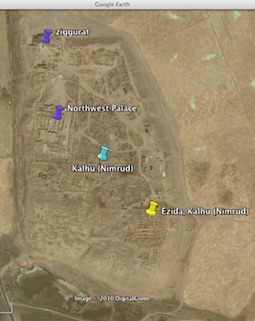
Image 3: Google Earth's imagery of Nimrud dates to October 2002. It shows how intensively the surface of the royal citadel TT was dug in the later 20th century. The restored palace and temples are particularly visible. © DigitalGlobe and Google. View large image.
As well as long-familiar Northwest Palace, many more buildings on Nimrud's citadel TT had become increasingly visible and comprehensible during the second half of the twentieth century (Image 3). In the 50s, Mallowan's team had re-excavated other areas which Layard had first explored. To the north of the palace were the ziggurat and its associated range of temples, while a cluster of buildings on the southwest corner of the mound proved to comprise Nabu's temple, the Governor's Palace, and the so-called Burnt Palace PGP .
In the 70s Meuszyński and colleagues also explored the central area of the citadel, where they discovered a large cache of sculpted bas-reliefs (7). These had been dismantled from Tiglath-pileser III's PGP so-called Central Palace PGP , perhaps by Esarhaddon PGP , ready for a redeployment that never came. Iraqi conservators TT consolidated and restored the temples for visitors, leaving the archaeologists' backfill to protect the rest for future generations.
The view from the lower city
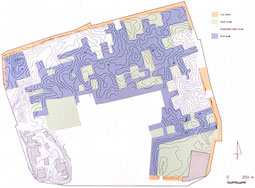
Image 4: The Italian topographical map TT of Nimrud's lower town was made by on-site surveying TT on the ground in the late 1980s. These days such techniques are supplemented by detailed study of aerial imagery, in order to identify features such as ancient roads and canals. © Centro Ricerche Archeologiche e Scavi di Torino. View this image on the University of Turin's website.
Finally, and perhaps most significantly, Kalhu was no longer seen as simply the royal citadel. Already in the 1950s and 60s, the BSAI expedition, led by Mallowan's young colleague David Oates PGP , had started work on the enormous building at the southeastern corner of the site. This soon became known as Fort Shalmaneser, after its royal founder, and yielded literally thousands of beautiful pieces of carved ivory. Originally dumped there as loot and tribute TT from Assyria's western neighbours, some of the ivories were cannily redeployed as gifts to the British team's sponsoring institutes worldwide.
In the late 80s two new projects began, headed by John Curtis of the British Museum TT and Paolo Fiorina PGP of the University of Turin (8), (9). Both were halted by Iraq's invasion of Kuwait and the subequent Gulf War TT in 1990-91 before they could do more than preliminary work on Fort Shalmaneser. But the Italian team also surveyed the rest of the area within the extensive city walls. Like many ancient Mesopotamian cities, Kalhu had not been densely settled but enjoyed large areas of open space, especially in the south (Image 4).
Pottery finds also showed the Italians that people had lived on the site from at least the sixth millennium BC — that is, some 8000 years ago! — to the first centuries of Islam, only a thousand years in the past. These were tantalising glimpses of a Kalhu far more extensive and long-lived than the Neo-Assyrian royal enclave.
Changing views from London
Nimrud and its Remains, Mallowan's final report on his work, came out in 1966 (10). Both in title and in style it was a deliberate echo of Layard's PGP Nineveh and its Remains (11). It rejected systematic presentation of finds in the now accepted manner in favour of narrative descriptions of the landscape and life onsite, interspersed with archictural descriptions of the major buildings, monuments and artefacts. Much of the work carefully described in the preliminary reports published in BSAI's journal Iraq never made it into the final publication.
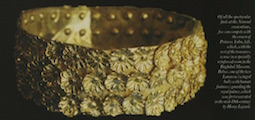 [/nimrud/images/mound/iln_1990-09-03-52.jpg]
[/nimrud/images/mound/iln_1990-09-03-52.jpg]Image 5: Queen Yabaʾ's flowery crown is one of the highlights of the spectacular Nimrud Treasure. The Illustrated London News carried a three-page colour feature on the finds in September 1990. (12). © Gale. View large image. [/nimrud/images/mound/iln_1990-09-03-52.jpg]
In parallel, the BSAI team were publishing the individual artefacts according to type—ivories, metalwork, tablets TT , for instance (13). This proved to be painfully slow work, hampered in the first place by the fact that finds had been dispersed to collections all over the world. From 1990 onwards UN sanctions TT banned international travel to Iraq, making it impossible to work on the objects still in Nimrud, Mosul PGP , and Baghdad PGP . Yet the venerable Illustrated London News TT continued its 150-year interest in Nimrud, reporting both on the Iraqis' spectacular gold finds, now dubbed the Nimrud Treasures, as well as the latest British work on site (14).
Despite this frustrating inability to access the site, or all of its artefacts, the turn of the millennium brought concerted attempts to synthesise what was known so far (15), (16),(17), (18). David and Joan Oates' landmark book Nimrud: an Imperial City Revealed of 2001 was the first major retrospective (19). It was not so much a history of Kalhu as a description of what had been found at Mallowan's Nimrud. Nevertheless, it was the first accessible overview of the site and a chance to salvage data that would have otherwise been lost. The text is tinted with nostalgia for late monarchy Iraq, for the authors' youth and their early love.
In early 2002, as the UN sanctions regime seemed to be easing, the BSAI convened an international conference on Nimrud at the British Museum (20). Iraqi archaeologists presented their research on the royal women's tombs while British and international colleagues evaluated past excavations and outlined new research agendas. It felt like the beginning of a new era – but just twelve months later the Iraq War TT broke out.
18 Dec 2019References
- Gadd, C.J., 1936. The Stones of Assyria: the Surviving Remains of Assyrian Sculpture, their Recovery and their Original Positions, London: Chatto and Windus. (Find in text ^)
- Meuszyński, J., 1981. Die Rekonstruktion der Reliefdarstellungen und ihrer Anordnung im Nordwestpalast von Kalḫu (Nimrūd), I: Räume: B.C.D.E.F.G.H.L.N.P. (Baghdader Forschungen 2), Mainz am Rhein: von Zabern. (Find in text ^)
- Paley, S.M. and R.P. Sobolewski, 1987. The reconstruction of the relief representations and their positions in the Northwest-Palace at Kalḫu (Nimrūd), II: Rooms I, S, T, Z, West wing (Baghdader Forschungen 10), Mainz am Rhein: von Zabern. (Find in text ^)
- Paley, S.M. and R.P. Sobolewski, 1992. The reconstruction of the relief representations and their positions in the Northwest-Palace at Kalḫu (Nimrūd), III: the principal entrances and courtyards (Baghdader Forschungen 14), Mainz am Rhein: von Zabern. (Find in text ^)
- al-Qaissi, R., 2008. "Restoration work at Nimrud", in J.E. Curtis, J. McCall, D. Collon and L. al-Gailani Werr (eds.), New Light on Nimrud: Proceedings of the Nimrud Conference, 11th-13th March 2002, London: British Institute for the Study of Iraq (free PDF from BISI, 22 MB), pp. 49–52. (Find in text ^)
- Damerji, M., 2008. "An introduction to the Nimrud tombs", in J.E. Curtis, H. McCall, D. Collon and L. al-Gailani Werr (eds.), New Light on Nimrud: Proceedings of the Nimrud Conference 11th-13th March 2002, London: British Institute for the Study of Iraq, pp. 81-82 (free PDF from BISI, 22 MB). (Find in text ^)
- Sobolewski, R., 1981. "The Polish work at Nimrud: ten years of excavation and study", Zeitschrift für Assyriologie und Vorderasiatische Archäeologie 71: 248–273. (Find in text ^)
- Curtis, J., D. Collon, A.R. Green and A. Searight, 1993. "British Museum excavations at Nimrud and Balawat in 1989", Iraq 55: 1–37 (PDF available via JSTOR for subscribers). (Find in text ^)
- Fiorina, P., 2008. "Italian excavations at Nimrud-Kalhu: chronological and stratigraphical problems", in J.E. Curtis, J. McCall, D. Collon and L. al-Gailani Werr (eds.), New Light on Nimrud: Proceedings of the Nimrud Conference, 11th-13th March 2002, London: British Institute for the Study of Iraq (free PDF from BISI, 22 MB), pp. 53–56. (Find in text ^)
- Mallowan, M.E.L., 1966. Nimrud and Its Remains, vols. I-II, London: Collins. (Find in text ^)
- Layard, A.H., 1849-1853. The Monuments of Nineveh: From Drawings Made on the Spot, vols. I–II, London: John Murray (free online edition of vol. 1 and vol. 2). (Find in text ^)
- Cappori, M., "Striking gold: the Nimrud Treasure", The Illustrated London News, 3 September 1990. (Find in text ^)
- Curtis, J., 2013. An Examination of Late Assyrian Metalwork: With Special Reference to Nimrud, Oxford: Oxbow Books. (Find in text ^)
- Cappori, M., "Striking gold: the Nimrud Treasure", The Illustrated London News, 3 September 1990. (Find in text ^)
- Reade, J.E., 1982. "Nimrud", in J.E. Curtis (ed.), Fifty Years of Mesopotamian Discovery: The Work of the British School of Archaeology in Iraq, 1932-1982, London: British School of Archaeology in Iraq, pp. 99-112 (free PDF from BISI, 131 MB). (Find in text ^)
- Russell, J.M., 1999. The Writing on the Wall: Studies in the Architectural Context of Late Assyrian Palace Inscriptions, Winona Lake: Eisenbrauns. (Find in text ^)
- Reade, J.E., 2002. "The ziggurrat and temples of Nimrud", Iraq 64, pp. 135-216 (PDF available via JSTOR for subscribers). (Find in text ^)
- Englund, K., 2003. Nimrud und seine Funde: Der Weg der Reliefs in die Museen und Sammlungen (Orient-Archäologie 12), Rahden: Verlag Marie Leidorf. (Find in text ^)
- Oates, D. and J. Oates, 2001. Nimrud, An Assyrian Imperial City Revealed, London: British School of Archaeology in Iraq ( free PDF from BISI, 128 MB). (Find in text ^)
- Curtis, J., H. McCall, D. Collon and L. al-Gailani Werr (eds.), 2008. New Light on Nimrud: Proceedings of the Nimrud Conference 11th-13th March 2002, London: British Institute for the Study of Iraq (free PDF from BISI, 22 MB). (Find in text ^)
Further reading
- Curtis, J., H. McCall, D. Collon and L. al-Gailani Werr (eds.), 2008. New Light on Nimrud: Proceedings of the Nimrud Conference 11th-13th March 2002, London: British Institute for the Study of Iraq (free PDF from BISI, 22 MB).
- George, D., 2012. "The treasures of Nimrud" (video lecture), online at Vimeo.
- Oates, D. and J. Oates, 2001. Nimrud, An Assyrian Imperial City Revealed, London: British School of Archaeology in Iraq ( free PDF from BISI, 128 MB).
Eleanor Robson
Eleanor Robson, 'Nimrud resurgent? Views of Kalhu in the new millennium', Nimrud: Materialities of Assyrian Knowledge Production, The Nimrud Project at Oracc.org, 2019 [http://oracc.museum.upenn.edu/nimrud/modernnimrud/onthemound/2000/]